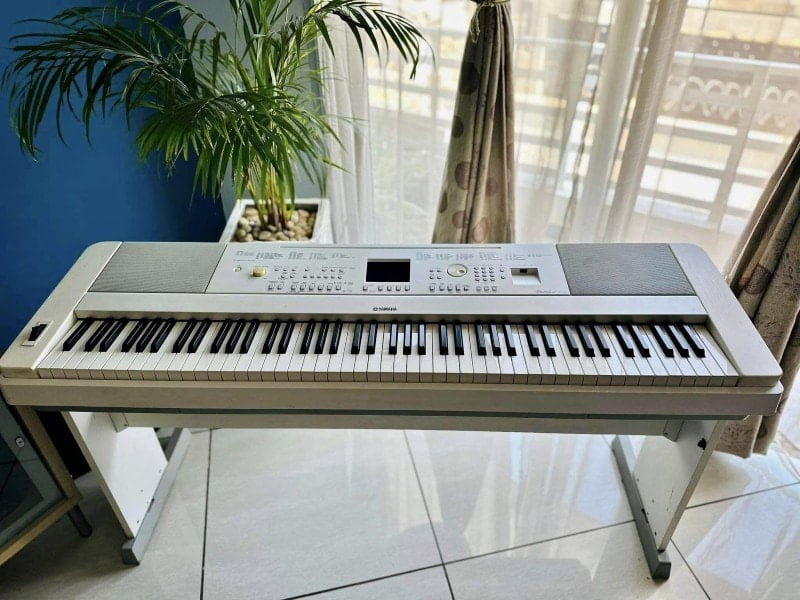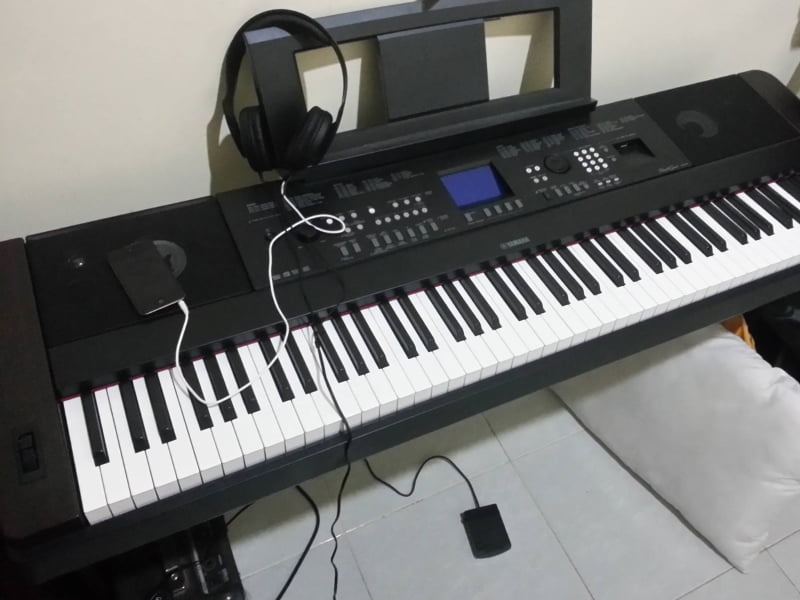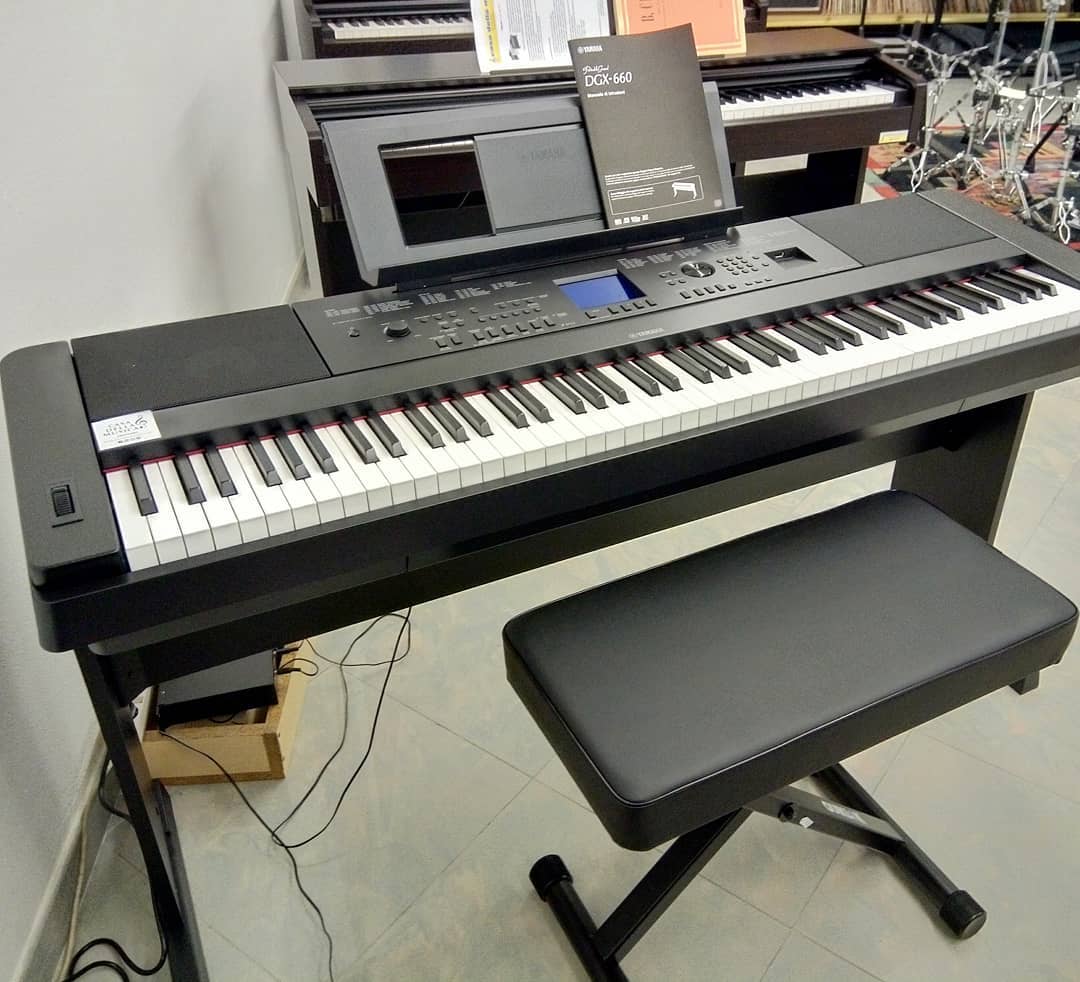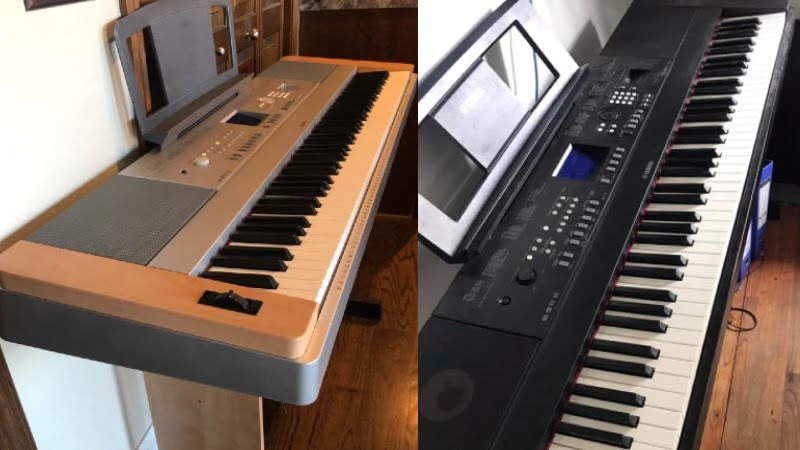Learn the details of these two great portable grand pianos in this Yamaha DGX-660 vs 650 review!
The Yamaha DGX line offers many great models. And while I can spend hours talking about any piano from this collection, today we’re doing a Yamaha DGX-660 vs DGX-650 comparison.
In this article, we’re looking at all the features, benefits, and even drawbacks of each piano. I won’t spare any detail – that way – you have a full picture of both pianos, what they can do, and who they are made for. So, choosing the right piano for your needs will be a breeze!
When running this comparison, I found that the DGX-660 had a slight edge. With more tones and better polyphony, it’s pretty obvious why the DGX-660 is a bit more expensive than its smaller sibling, the DGX-650.
That said, the right piano for you really depends on your needs and preferences as a pianist. So, keep reading so that you get a detailed view of both pianos so that you know exactly which one is right for you.
Yamaha DGX-660 vs 650: Comparison Chart




Last update on 2025-07-09 / Affiliate links / Images from Amazon Product Advertising API
Yamaha DGX-660 vs 650: A Head to Head Comparison
After testing the tone, feel, and piano features of each instrument, the Yamaha DGX-660 came out on top. The final score was 3-1, which wasn’t really a surprise. The DGX-660 is an upgrade to the DGX-650, so while they same some features, the 660 does everything the DGX-650 does but much better.
If you’re on a tight budget, there’s nothing wrong with the DGX-650. But if you’re willing to spend a bit more for a more versatile and functional piano, I would recommend the Yamaha DGX-660.
Tone
The winner: Yamaha DGX-660

When it came to the piano tones, these instruments sounded very similar. I kind of expected this since both pianos share the same tone engine. However, the main difference maker was the sound library. The sound library of the Yamaha DGX-660 is much wider than the 650, which makes it way more versatile and the better option for pianists that play various musical styles and genres.
+Tone Generation
The tone engine on both pianos is the Pure CF Sound Engine, which you can find in a lot of Yamaha pianos. This is a great tone engine as it derives its piano sounds from real Yamaha CF Grand Pianos. These are some of the most popular and well-loved grand pianos available, and having a digital piano that can emulate that sound is great.
When I tried out the piano tones on both instruments, I instantly fell in love. There was richness and brightness to the tones that you don’t get from other brands. On top of that, it sounded very close to the real thing, which is something you always need to look for with a digital piano.
That said, keep in mind that only the piano tones rely on the Pure CF Sound Engine. The other voices on the pianos come from other sound packs and generators. So, there will be a drop-off in quality when you go from the piano tones to some of the more unique sounds on the pianos.
+Sound Library
Both of these pianos have a wide sound library. The Yamaha DGX-660 has over 500 voices. As mentioned earlier, the DGX-660’s piano voices are from the Pure CF Engine, while the others are from other sound packs. So, while you get variety, don’t expect all of the tones to be as realistic or rich as the piano tones.
That said, this variety is great because you have more freedom to experiment and find tones that help you develop a unique playing style. And even if some voices aren’t as good as others, you’ll still find many uses for them, especially if you’re still discovering your sound.
The DGX-650 boasts a similar sound library, though you have 11 fewer voices. This isn’t that big of a difference, but you do get less variety with this model. This is why I recommend the Yamaha DGX-660 for anyone in need of more variety and options when playing the piano.

Feel
The winner: Tie
The next comparison point I had between these two pianos was the feel. You always want to get a digital piano that makes you forget you aren’t playing an acoustic piano. To do this, you need to make sure the piano has a good hammer action system. Both the Yamaha DGX-660 and DGX-650 come with a great hammer action system, which is why they feel very similar to an acoustic piano.
And since they have the same hammer action system, I couldn’t really choose a winner for this category.
+Hammer Action
These Yamaha pianos come with the Yamaha Graded Hammer Standard or GHS. This is one of the more affordable hammer action systems from the brand. However, you’ll notice this system is installed on many pianos in various price ranges because of how well it works for the price.
This is one of the most affordable hammer action systems that offers a graded weight. When you play an acoustic piano, one of the defining features is the hammer action and the way the bass keys feel heavier than the treble keys.
Typically, fully-weighted pianos have a uniform weight on all the keys. If you’re a beginner, you may not notice this difference. But if you get used to playing acoustic pianos, the difference becomes more evident, and it will become something you look for in a digital piano.
So, it’s great that both pianos have a graded hammer action. That said, I did notice that the keys didn’t spring back as fast as I’d want to. However, for the price, getting a graded hammer action system is more than enough!
Piano Features
The winner: Yamaha DGX-660
The last consideration I had in this comparison was the piano features. But since these two pianos are from the same product line, a lot of the piano features are the same. In fact, the only major difference between the two is the polyphony, which I believe is the most important additional piano feature to consider.
The Yamaha DGX-660 has great polyphony than the DGX-650, so it won the point and the entire comparison. The DGX-650 put up a surprisingly good fight for a more affordable piano, but it couldn’t win over the DGX-660 when all was said and done.

+Polyphony
Polyphony is a very important feature for digital pianos. This refers to the piano’s ability to play multiple notes simultaneously. Ideally, you want to have a large polyphony on your digital piano so that you can let notes ring out longer and play dense chords while still getting a clear and crisp sound.
The Yamaha DGX-660 comes with 192-note polyphony. This is great as you can play just about any piano piece you want and be very expressive with your playing at the same time. It would have been nice to see 256-note polyphony, but that’s a feature usually reserved for more premium pianos.
That said, the Yamaha DGX-650 only has 184-note polyphony. This isn’t that much smaller than the DXG-660 but in comparisons this close, the small details matter. So, if you want to be more expressive and open up more options in your playing, I recommend getting the DGX-660.
Yamaha DGX-660 vs 650: The Similarities
These pianos come from the same product line and brand, so it should be no surprise that they have a lot of similarities. To start, they share the same tone engine, which is why the sound quality of both pianos is roughly the same. On top of that, they share the same hammer action system, so you can expect both pianos to feel fairly close to a real acoustic piano.
But that isn’t all.
These pianos also have the same effects and playing modes. While the effects aren’t the best, they give you a lot of control over your tone. And with all the different playing modes, you’ll be able to do a whole lot with either piano.
I would recommend either piano to anyone looking for a digital piano. But if you need the most value for your money, the Yamaha DGX-660 is your best pick.
Quick Rundown of the Yamaha DGX-660
- The Pure CF Sound Engine faithfully reproduces the tone of a meticulously sampled and highly acclaimed Yamaha concert grand piano
- GHS weighted action is heavier in the low register and lighter in the high, just like an acoustic piano
- Score display puts music notation of MIDI songs on the screen, helping you play your favorites by following the bouncing ball
- The Piano room lets you choose from a variety of pianos and acoustic settings to create your own personal piano environment
- The 6 track recorder allows you to capture your performances and song ideas, then add additional layers to spice up your pieces
Last update on 2025-07-09 / Affiliate links / Images from Amazon Product Advertising API
Quick Rundown of the Yamaha DGX-650
- PureCF-sampled piano: Sampled from Yamaha's acclaimed CFIIIS concert grand, no other digital piano brand at this price delivers recordings from such a high-end instrument.
- AUX line input: Connect any device with a line output like mobile devices, computers, mixers or even another keyboard and hear it through the internal speakers.
- 128-note polyphony: Provides enough horsepower for a dropout-free performance while layering two Voices and playing two-handed, sustained chords.
- 88-note, weighted GHS action: Heavier touch in the low end and lighter in the highs, just like an acoustic piano.
- "You Are The Artist" Series: Professionally-arranged, play-along songs matched with song books from Hal Leonard. Learn to play songs by artists like Elton John, Taylor Swift, Adele and more.
Last update on 2025-07-09 / Affiliate links / Images from Amazon Product Advertising API
Product Video
Related Articles to Yamaha Dgx 660
- Yamaha YDP-164 vs DGX-660: Why You Should Go for the DGX-660
- Yamaha DGX-660 vs Roland FP-90: Why the Roland FP-90 Is the Better Pick
- Yamaha DGX-530 vs 660: Why the DGX-660 Is the Better Pick
- Yamaha DGX-505 vs 660: Why the DGX-660 Is the Better Pick
- Yamaha DGX-660 vs DGX-640: A DGX Comparison
- Yamaha DGX-660 vs DGX-630: A DGX Comparison
- Yamaha DGX-620 vs 660: Finding the Best DGX Model
- Yamaha DGX-660 vs YDP-163: Which Is the Better Piano?
- Yamaha DGX-660 vs Roland Juno DS-88: Which Is the Better Piano?
- Yamaha DGX-660 vs Casio PX-360: Which Is the Better Piano?
- Yamaha DGX-660 vs YDP-144: Which Is the Better Yamaha Piano?
- Yamaha DGX-660 vs Korg Havian 30: Which Is the Better Digital Piano?
- Yamaha DGX-660 vs Casio CGP-700: Which Is the Better Pick?
- Yamaha DGX-660 vs YPG-535: Finding the Best Yamaha Digital Piano
- Yamaha DGX-660 vs P515: Is the P515 Worth the Extra Cost?
- Yamaha DGX-660 vs P-115: Which Yamaha Model Is Better?
- Yamaha DGX-660 vs Casio PX-560: Which Piano Offers More Value For The Money
- Korg XE-20 vs Yamaha DGX-660: Finding the Best Digital Piano
- Yamaha P45 Vs DGX-660: A Head-to-Head Comparison
- Yamaha DGX 670 Vs 660: The Distinct Difference In Details You Need To Know About
- Yamaha YDP-103 Vs DGX-660: Which Is The Better Yamaha Piano?
- Casio PX-770 Vs Yamaha DGX-660: Should You Get A Portable Or Console Digital Piano?
- Yamaha P71 vs DGX-660: Can the Amazon Exclusive Beat Out the Premium Model?
- Yamaha P125 vs DGX 660 Comparison: Can the P125 Hold Its Own Against the DGX 660?
Related Articles to Yamaha Dgx 650
References:
- Yamaha DGX-660: https://europe.yamaha.com/en/products/musical_instruments/pianos/portable_grand/dgx-660/specs.htmlv
- Yamaha DGX-650: https://usa.yamaha.com/products/musical_instruments/pianos/portable_grand/dgx-650/specs.html
Lulacruza is an electronic folk duo operating at the junction of the hypermodern and the ancient. Our music weaves together hypnotic female singing, South American folk instruments and electronic processing, while channeling pulsating waves from the source of creation.
Lalucruza is also a community where you can connect with other music lovers to collaborate, exchange ideas and share knowledge. A platform for who wants to learns the basics of playing piano, guitar, drum masters’ technique, etc.. is the premise of our website.
